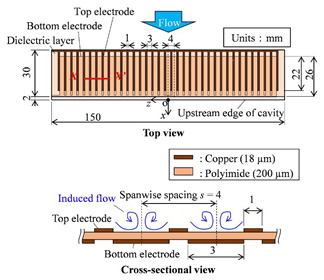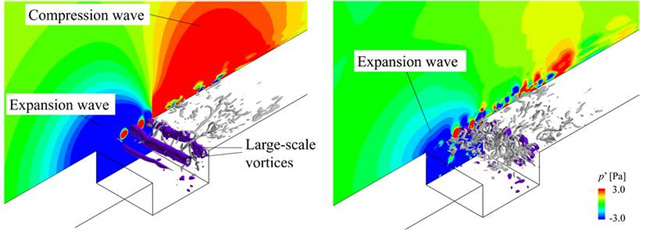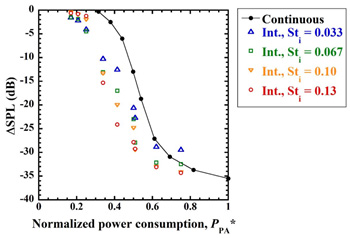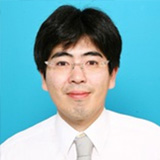
ここからコンテンツです。

Noise reduction via intermittent control utilizing a plasma actuator
Toward a quieter and more comfortable transportation systemBy Hiroshi Yokoyama
A research team lead by Associate Professor Hiroshi Yokoyama in the Department of Mechanical Engineering at Toyohashi University of Technology developed a method for reducing aerodynamic noise via the use of plasma. Cavity flow, such as the flow of air between carriages on high-speed trains, often radiates aerodynamic noise. A plasma actuator inducing flow was applied to suppress this noise. By periodically switching off the power of the plasma actuator, a higher reduction in sound pressure level was observed when compared with continuous operation under the same power consumption.
The research team of Associate Professor Hiroshi Yokoyama has developed a method for reducing aerodynamic noise via plasma generation in the air. The process known as cavity flow, the flow of air over a hole or concave shape, is capable of generating significant aerodynamic noise. The plasma actuator is a device that can induce various flows in air via plasma generation. Using a plasma actuator to suppress this noise, the team achieved a reduction of up to 35 dB of aerodynamic noise. Furthermore, the periodic switching off and on of the plasma actuator at an appropriate frequency led to a better performance in sound reduction when compared to the continuous operation of the plasma actuator under the same power consumption. The results of their research were published in Physics of Fluids on October 9, 2020.

Cavity flows, such as the flow of air between carriages on high-speed trains or around the landing gear configurations of aircraft, radiate aerodynamic noise at a level which can cause discomfort for passengers. This problem has recently been tackled by the use of a flow-induced device consisting of top and bottom electrodes and a dielectric layer between them, known as a plasma actuator, to achieve flow control.
The research team demonstrated that the plasma actuator successfully weakened vortices that can cause intense levels of sound. Thus, the aerodynamic noise from the cavity flow was reduced by as much as 35 dB. Furthermore, to reduce the power required for driving the plasma actuator, the plasma actuator was periodically switched off. This type of driving is termed as "intermittent control." Intermittent control at an appropriate frequency leads to higher sound reduction when compared with continuous control under the same power consumption. The simulations of flow and sound in a supercomputer clarified a weakening effect on the vortices, which cause intense sound, thanks to the control via a plasma actuator. Moreover, the cavity tone was continuously reduced even via intermittent control at an appropriate frequency.

The plasma actuator’s performance is currently still inhibited by the limitation in achievable induced flow speed and the treatment of ozone generation with plasma. However, the research team believes that this noise reduction method will contribute, directly or indirectly, to the design of more comfortable transport vehicles. Aerodynamic noise becomes increasingly problematic as the speed of transport vehicles is increased. Hence, the development of a reduction mechanism for aerodynamic noise can help us to realize faster transport vehicles, while keeping the noise levels down.

The mechanism of acoustic radiation from the cavity flow is similar to that of a whistle. If a finger is moved to or from the mouth during whistling, the whistle tone stops and starts. It is important to consider the effect of the speed at which the finger is moved. Furthermore, it is important to determine whether the tone can be stopped by sufficiently fast movement. By utilizing the fast time response of the plasma actuator, the results of this study addressed this question. The results indicated a continuous reduction in the tone via control at an appropriate frequency, which is dependent on the cavity flow configurations.
This study was supported by the Ministry of Education, Culture, Sports, Science, and Technology (MEXT) of Japan under JP17K06153.
Reference
Hiroshi Yokoyama, Keisuke Otsuka, Katsuya Otake, Masahito Nishikawara, Hideki Yanada, "Control of Cavity Flow with Acoustic Radiation by an Intermittently Driven Plasma Actuator", Physics of Fluids, 32(10), 106104-1-106104-20, 2020 October, DOI:10.1063/5.0017658.
プラズマを利用した空力騒音の低減
より静粛な快適な輸送機関を目指してBy 横山 博史
豊橋技術科学大学機械工学系の横山博史准教授の研究チームは、プラズマを用いた騒音低減手法を開発しました。高速列車の車間部周りの流れのようなキャビティ流れでは強い音が発生する場合があります。プラズマの生成により生じる誘起流を利用するプラズマアクチュエータにより、こうした音の抑制を試みました。同等のプラズマアクチュエータの消費電力で比較した場合、プラズマアクチュエータを間欠的に駆動することで、連続的に駆動した場合より、より大きな騒音低減が得られることがわかりました。
横山博史准教授の研究チームは、空気中のプラズマ発生を利用し、気流から発生する音(空力騒音)を低減する手法を開発しました。穴や凹形状を通る流れはキャビティ流れと呼ばれ、しばしば空力騒音(キャビティ音)が発生します。プラズマアクチュエータは空気中にプラズマを発生させ様々な流れを誘起できるデバイスです。そこで、プラズマアクチュエータをこのキャビティ音の低減に適用しました。その結果最大35dBの騒音低減を達成しました。さらに、適切な周波数でプラズマアクチュエータのオン・オフを切り替えることで、同等のプラズマアクチュエータの消費電力で比較した際、連続的に駆動する場合より大きく騒音を低減できることを明らかにしました。この研究成果は2020年9月10日にPhysics of Fluidsに掲載されました。
高速鉄道の車両車間部や飛行機の着陸装置格納部のようなキャビティ流れからは、強い空力騒音が発生する場合があります。こうしたキャビティ音は乗客にとって不快であるため、低減する必要があります。近年、上部と下部二つの電極によって薄い誘電体を挟んだ形状のプラズマアクアチェータと呼ばれるデバイスが、流体制御デバイスとして開発が進んでいます。
研究チームは、プラズマアクチュエータにより、強いキャビティ音の原因となる渦構造を弱めることに成功しました。その結果、キャビティ音を最大35dB低減することができました。さらに、プラズマアクチュエータを駆動するために必要な消費電力を低減するため、プラズマアクチュエータのオン・オフを周期的に切り替える駆動を行いました。このような駆動を間欠駆動と呼びます。適切な周波数での間欠制御は同等の消費電力で比較した際、連続的に駆動する場合より大きく騒音を低減することができました。流れや音についてスーパーコンピュータを用いて解析した結果、プラズマアクチュエータにより制御を行うことで、強い音の原因となる気流中の渦構造が弱まっていることがわかりました。さらに適切な間欠周波数での間欠駆動によりキャビティ音は常に抑制された状態となることがわかりました。
キャビティ音の発生メカニズムは口笛と似ています。口笛を吹いている時に指を口につけたり離したりすると、口笛は止まったり、鳴り出したりします。研究チームは指の動かすスピードの影響に着目しました。十分早く指を動かすことによって口笛は常に止まった状態になるのか、止まったり鳴り出したりを素早く繰り返すのか疑問を持ちました。プラズマアクチュエータの高い時間応答異性を利用し、この一つの答えがでました。適切な周波数での間欠制御により連続的な音の低減ができることを明らかにしました。この適切な間欠周波数がキャビティの形状に依存することも明らかになりました。
プラズマアクチュエータの実用化において、誘起流の速度の限界があることや高電圧を用いることの安全性の問題などがまだあります。しかしながら、研究チームは、この騒音制御手法が直接的もしくは間接的に快適な輸送機関の開発につながると信じています。輸送機関の高速化を考える際に空力騒音の増加が大きな問題の一つとなります。そのため、空力騒音の低減機構を確立することは低騒音なより速い輸送機関の開発にもつながると考えられます。
本研究はJSPS科研費JP17K06153の助成を受けて実施されました。
Researcher Profile

| Name | Hiroshi Yokoyama |
|---|---|
| Affiliation | Department of Mechanical Engineering |
| Title | Associate Professor |
| Fields of Research | Fluid dynamics, Aeroacoustics, Computational Fluid Dynamics, Turbulence Engineering |
ここでコンテンツ終わりです。
